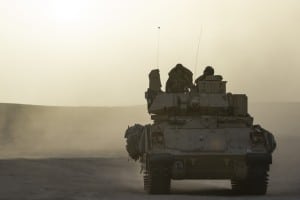The Biden administration on Friday detailed its largest security aid deal to date for Ukraine, to include a $2.85 billion weapons package with 50 Bradley fighting vehicles as well as $225 million in Foreign Military Financing (FMF) funds “to build the long-term capacity and support modernization of Ukraine’s military.”
The State Department also announced plans to provide $682 million in FMF funds for a group of European partners and allies “to help incentivize and backfill donations of military equipment to Ukraine.”

“In the longer term, this Foreign Military Financing funding may be used to rebuild Ukraine’s capacity to provide for its own defense through development and modernization of its armed forces,” Secretary of State Antony Blinken said in a statement. “Additionally, the over $682 million in Foreign Military Financing for European allies and partners will be used to build the capacities of those impacted by Russia’s war in Ukraine to deter and defend against emergent threats to territorial sovereignty, increase professionalization and modernization of security forces, enhance partner military integration with NATO, and strengthen defensive cyber capabilities.”
Following a call between President Biden and German Chancellor Olaf Scholz on Thursday, the White House noted the administration’s intent to provide Ukraine with Bradley fighting vehicles for the first time to assist in Kyiv’s fight against Russia’s ongoing invasion (Defense Daily, Jan. 5).
Laura Cooper, deputy assistant secretary of defense for Russia, Ukraine and Eurasia, told reporters on Friday the 50 BAE Systems-built M2A2 Bradley vehicles for Ukraine will come with 500 TOW anti-tank missiles and 250,000 rounds of 25mm ammunition.
“The Bradley vehicles will further enhance Ukraine’s ability to conduct complex maneuvers in almost all weather conditions and terrain, especially in the South and the East of the country. The Bradley is a tracked armored vehicle that is agile, provides mounted firepower and is a significant anti-armor capability. This complements a series of armor commitments by the United States and our allies,” Cooper said.
Cooper added the process for training Ukrainians on the vehicles and then getting the Bradleys into Ukraine will likely “take a couple of months.”
The new $2.85 billion weapons package for Ukraine, which is the 29th drawdown of equipment from existing Pentagon inventories, also includes 100 M113 Armored Personnel Carriers, 55 Mine Resistant Ambush Protected Vehicles (MRAP) and 138 Humvees.
“These additional M113s, beyond the 200 we have already committed, will further enhance Ukraine’s fleet of tracked armored vehicles to support operations in the East and South. We have now committed more than 1,300 Humvees to enable Ukraine to protect and transport their forces during maneuver operations. The MRAPs will improve Ukraine’s ability to maneuver, including through heavily mined terrain,” Cooper said. “These capabilities will complement and work with the expanded U.S.-led training beginning this month that will build Ukraine’s capacity to conduct joint maneuver and combined operations.”
Cooper noted the package includes “significant artillery commitments” to include the first delivery of 18 155mm Paladin self-propelled howitzers, as well as 70,000 155mm artillery rounds, 500 precision-guided 155mm artillery rounds and 36 more 105mm towed howitzers with 95,000 105mm artillery rounds.
The package also includes 4,000 Zuni rockets to be mounted on Ukraine’s existing aircraft, as well as 1,200 155mm rounds of Remote Anti-Armor Mine (RAAM) Systems, 10,000 120mm mortar rounds and additional ammunition for High Mobility Artillery Rocket Systems (HIMARS) launchers.
For air defense, which Cooper cited as ongoing top priority for Ukraine, the U.S. is providing RIM-7 missiles to be integrated with Ukraine’s Buk shorter-range defense system.
“These can be integrated into Ukraine’s Soviet-era tactical surface-to-air missile systems. And this provides the Ukrainians with additional capabilities to defend against Russian aerial attacks,” Cooper said.
Cooper also cited France’s recent announcement that it would provide Ukraine with AMX-10 light tanks and Germany’s move to supply Marder infantry fighting vehicles as well as a Patriot air defense battery.
“We commend Germany for its important commitment this week to also supply a Patriot air defense battery to Ukraine. This will supplement the U.S. donation of a Patriot battery announced in December,” Cooper said.
During Ukrainian President Volodymyr Zelenskyy’s visit to D.C. last month, the White House announced plans to provide Kyiv with a battery of the Raytheon Technologies [RTX]-built air defense capability as part of a $1.85 billion weapons aid package (Defense Daily, Dec. 21).
Cooper was also asked about the U.S.’ decision to not include Abrams tanks as part of a security aid package to date.
“This is something that we absolutely agree that Ukraine does need tanks. It’s one of the reasons that we partnered with the Netherlands to refurbish a number of T-72 tanks that are already arriving on the battlefield. But we have to be cognizant of maintenance and sustainment considerations with tanks. And, certainly, we know that the Abrams tank, in addition to being a gas guzzler, is quite challenging to maintain. So we want to look across the board at the range of tank capabilities and see where we can all support Ukraine,” Cooper said.
A $400 million security assistance package for Ukraine approved in early November included funds to refurbish Czech Republic-owned T-72 tanks, with the Netherlands also agreeing to send 45 of the Soviet-era tanks to Kyiv as well (Defense Daily, Nov. 4).